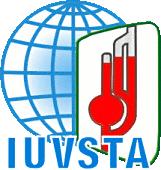Speaker
Description
Indium oxide (In$_2$O$_3$) is a ubiquitous material in OLEDs and photovoltaics
due to an ideally matched optical transmission window and
metal-like conductivity at room temperature when doped with Sn (as
ITO). When In$_2$O$_3$ is paired with organic materials, a nearly universal
fabrication step is the introduction of a thin organic buffer layer to improve
the charge injection efficiency from In$_2$O$_3$ to the organic active
layers. Using a combination of STM, nc-AFM, and local spectroscopy
(STS), we probe the adsorption structure and density of states (DOS)
at the prototypical copper phthalocyanine (CuPc)-In$_2$O$_3$ interface. We
focus on the stoichiometric (111) surface but also investigate the effects
of dissociated water coadsorbed in UHV. STM/AFM imaging
reveals single CuPc molecules adsorb in a flat, slightly tilted geometry
in three symmetry-equivalent orientations. Increasing the coverage
leads to (densely packed) 1D chains oriented along the <110>
directions. With increasing coverage up to 1 ML, first, a (2×2) and
then a (1×1) superstructure is found. Finally, differential conductance
(dI/dV) measurements reveal the energetic positions of the HOMO
and LUMO states which are critical for improving charge injection.

